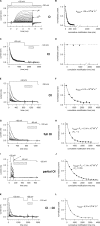Cross talk between activation and slow inactivation gates of Shaker potassium channels
- PMID: 17043151
- PMCID: PMC2151579
- DOI: 10.1085/jgp.200609644
Cross talk between activation and slow inactivation gates of Shaker potassium channels
Abstract
This study addresses the energetic coupling between the activation and slow inactivation gates of Shaker potassium channels. To track the status of the activation gate in inactivated channels that are nonconducting, we used two functional assays: the accessibility of a cysteine residue engineered into the protein lining the pore cavity (V474C) and the liberation by depolarization of a Cs(+) ion trapped behind the closed activation gate. We determined that the rate of activation gate movement depends on the state of the inactivation gate. A closed inactivation gate favors faster opening and slower closing of the activation gate. We also show that hyperpolarization closes the activation gate long before a channel recovers from inactivation. Because activation and slow inactivation are ubiquitous gating processes in potassium channels, the cross talk between them is likely to be a fundamental factor in controlling ion flux across membranes.
Figures







Similar articles
-
The activation gate controls steady-state inactivation and recovery from inactivation in Shaker.J Gen Physiol. 2020 Aug 3;152(8):e202012591. doi: 10.1085/jgp.202012591. J Gen Physiol. 2020. PMID: 32442242 Free PMC article.
-
Status of the intracellular gate in the activated-not-open state of shaker K+ channels.J Gen Physiol. 2005 Nov;126(5):419-28. doi: 10.1085/jgp.200509385. J Gen Physiol. 2005. PMID: 16260836 Free PMC article.
-
Molecular rearrangements in S6 during slow inactivation in Shaker-IR potassium channels.J Gen Physiol. 2023 Jul 3;155(7):e202313352. doi: 10.1085/jgp.202313352. Epub 2023 May 22. J Gen Physiol. 2023. PMID: 37212728 Free PMC article.
-
Use of voltage clamp fluorimetry in understanding potassium channel gating: a review of Shaker fluorescence data.Can J Physiol Pharmacol. 2009 Jun;87(6):411-8. doi: 10.1139/y09-024. Can J Physiol Pharmacol. 2009. PMID: 19526034 Review.
-
The search is on for the voltage sensor-to-gate coupling.J Gen Physiol. 2002 Oct;120(4):475-81. doi: 10.1085/jgp.20028657. J Gen Physiol. 2002. PMID: 12356850 Free PMC article. Review. No abstract available.
Cited by
-
Probing the cavity of the slow inactivated conformation of shaker potassium channels.J Gen Physiol. 2007 May;129(5):403-18. doi: 10.1085/jgp.200709758. Epub 2007 Apr 16. J Gen Physiol. 2007. PMID: 17438120 Free PMC article.
-
A two-gate model for the ryanodine receptor with allosteric modulation by caffeine and quercetin.Eur Biophys J. 2008 Jul;37(6):793-806. doi: 10.1007/s00249-008-0271-6. Epub 2008 Feb 6. Eur Biophys J. 2008. PMID: 18253727
-
Mapping the sequence of conformational changes underlying selectivity filter gating in the K(v)11.1 potassium channel.Nat Struct Mol Biol. 2011 Jan;18(1):35-41. doi: 10.1038/nsmb.1966. Epub 2010 Dec 19. Nat Struct Mol Biol. 2011. PMID: 21170050
-
The activation gate controls steady-state inactivation and recovery from inactivation in Shaker.J Gen Physiol. 2020 Aug 3;152(8):e202012591. doi: 10.1085/jgp.202012591. J Gen Physiol. 2020. PMID: 32442242 Free PMC article.
-
Calcium ions open a selectivity filter gate during activation of the MthK potassium channel.Nat Commun. 2015 Sep 23;6:8342. doi: 10.1038/ncomms9342. Nat Commun. 2015. PMID: 26395539 Free PMC article.
References
-
- Ashcroft, F.M. 2000. Ion Channels and Disease: Channelopathies. Academic Press, San Diego. 481 pp.
-
- Baukrowitz, T., and G. Yellen. 1995. Modulation of K+ current by frequency and external [K+]: a tale of two inactivation mechanisms. Neuron. 15:951–960. - PubMed
-
- Bezanilla, F. 2000. The voltage sensor in voltage-dependent ion channels. Physiol. Rev. 80:555–592. - PubMed
-
- Cordero-Morales, J.F., L.G. Cuello, Y. Zhao, V. Jogini, D.M. Cortes, B. Roux, and E. Perozo. 2006. Molecular determinants of gating at the potassium-channel selectivity filter. Nat. Struct. Mol. Biol. 13:311–318. - PubMed

